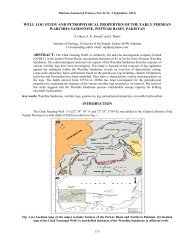synthesis of single cell biomass of candida utilis by - Paas.com.pk
synthesis of single cell biomass of candida utilis by - Paas.com.pk
synthesis of single cell biomass of candida utilis by - Paas.com.pk
Create successful ePaper yourself
Turn your PDF publications into a flip-book with our unique Google optimized e-Paper software.
Pakistan Journal <strong>of</strong> Science (Vol. 62 No. 1 March, 2010)NaOH/HCl before sterilization at 121 o C for 15 min. Aftersterilization the media was inoculated with 1mlsuspension <strong>of</strong> Candida <strong>utilis</strong>. The inoculated flasks wereincubated at 30 ˚C with the agitation speed <strong>of</strong> 120rpm for4 days. After fermentation, <strong>biomass</strong> was separated <strong>by</strong>centrifugation (5000 rpm, 10 ˚C for 10 minutes). Thepellet containing the <strong>cell</strong> mass was dried at 40 ˚C in anincubator for 24 hrs and <strong>cell</strong> free broth was used forfurther analysis.OPTIMIZATION OF PROCESS PARAMETERSEffect <strong>of</strong> Fermentation Period: Effect <strong>of</strong> fermentationperiod was studied <strong>by</strong> harvesting samples at 24, 48, 72,96 and 120hrs to check the maximum yield <strong>of</strong> <strong>biomass</strong> atthe mentioned incubation periodEffect <strong>of</strong> Inoculum Size: Different concentrations <strong>of</strong>inocula sizes i.e. 2, 3, 4, 5 and 6% v/v were used toanalyze for the maximum production <strong>of</strong> <strong>single</strong> <strong>cell</strong><strong>biomass</strong> <strong>of</strong> Candida <strong>utilis</strong>.Effect <strong>of</strong> Initial pH <strong>of</strong> medium: Effect <strong>of</strong> differentinitial pH values viz. 4, 5, 6, 7 and 8 <strong>of</strong> growth media waschecked before sterilization to enhance the maximumproduction <strong>of</strong> <strong>biomass</strong> <strong>of</strong> Candida <strong>utilis</strong>.Effect <strong>of</strong> Temperature: Different incubationtemperatures i.e. 20, 25, 30, 35, and 40 o C were used tocheck the maximum production <strong>of</strong> <strong>single</strong> <strong>cell</strong> <strong>biomass</strong>.Effect <strong>of</strong> different Carbon sources: The Fruit WasteExtract was supplemented with different carbon sourcesuch as glucose, sucrose, soluble starch, maltose andwheat bran each at 0.5 % w/v to check the maximumproduction <strong>of</strong> <strong>biomass</strong>.Effect <strong>of</strong> different Nitrogen sources: Different nitrogensources, organic (urea, peptone, meat extract, yeastextract and lab-lamco powder) and inorganic (ammoniumnitrate, ammonium sulphate, ammonium dihydrogenphosphate, ammonium chloride, ammonium phosphateand ammonium citrate) nitrogen sources weresupplemented to the growth media, each at 0.25% w/v tocheck the maximum production <strong>of</strong> <strong>biomass</strong>.ANALYTICAL PROCEDURECompositional Analysis <strong>of</strong> Substrate: The moisture,ash and crude fat contents <strong>of</strong> the substrate weredetermined <strong>by</strong> the methods <strong>of</strong> AOAC (2005).Total Protein Estimation: Total Protein in thefermented broth was estimated <strong>by</strong> the method <strong>of</strong> Lowryet al. (1951) and nitrogen content <strong>of</strong> dry <strong>biomass</strong> <strong>of</strong> theCandida <strong>utilis</strong> was estimated <strong>by</strong> micro-Kjeldhal method(AOAC., 2005).Total Carbohydrates Estimation: Total carbohydratesin the <strong>cell</strong> free extracts were estimated according to themethod described <strong>by</strong> Dubois et al. (1956) using phenolsulphuric acid method.RESULTS AND DISCUSSIONCompositional Analysis <strong>of</strong> Substrate: The proximateanalysis <strong>of</strong> fruit waste (banana and orange) showed a<strong>com</strong>position <strong>of</strong> 81% moisture, 5.75%ash, 3.90% crudefats, 3.82% crude protein and 40.34% total carbohydrates(Table 1). Nazem et al. (2007) studied the nutritive value<strong>of</strong> the orange pulp and found that it consisted <strong>of</strong> 79%moisture, 6.5% ash, 6.2% crude fats and 6.8% crudeprotein. Essien et al. (2005) reported on mould growthand <strong>biomass</strong> production using waste banana skin thatconsisted <strong>of</strong> 78.4% moisture, 13.44% ash, 11.60% crudefats, 7.87% crude protein and 59.51% carbohydrates. Dueto the mixture <strong>of</strong> the banana and orange waste theseproximate <strong>com</strong>position do not match with the optimumproximate <strong>com</strong>position <strong>of</strong> the fruit waste observed inpresent study. The results <strong>of</strong> the chemical analysis <strong>of</strong> fruitwaste extract was <strong>com</strong>parable with the work <strong>of</strong> Nazem etal. (2007) and Essien et al. (2005). All these resultsindicated that that fruit waste can be used as a potentialsubstrate for microbial growth due to its reasonablecarbohydrates contents.Effect <strong>of</strong> Fermentation Period: Maximum production <strong>of</strong><strong>biomass</strong> was found after four days <strong>of</strong> incubation asshown in the Figure 1. Ravinder et al. (2003) studied theproduction <strong>of</strong> mutant Aspergillus oryzae SCP fromdeoiled rice bran and obtained maximum SCP after 3days. Similarly, Adoki (2002) studied the culturalcharacteristics <strong>of</strong> Candida sp. in waste conversion for<strong>single</strong> <strong>cell</strong> protein enriched feed supplement productionand found maximum SCP after 3 days <strong>of</strong> fermentation.The result shows some variation which might had existeddue different nature <strong>of</strong> the strain isolated from differenthabitats.Effect <strong>of</strong> Inoculum Size: Different inocula sizes viz., 2,3, 4, 5 and 6% v/v were studied as shown in the figure 2which indicated that maximum yield <strong>of</strong> Candida <strong>utilis</strong><strong>biomass</strong> was obtained with the 4% (v/v). Differentworkers obtained maximum <strong>biomass</strong> production withdifferent inoculum size. Rajoka et al. (2005) reportedmaximum yield <strong>of</strong> Candida <strong>utilis</strong> <strong>biomass</strong> with 10% (v/v)inoculum size on rice bran and Ravinder et al. (2003)obtained maximum Aspergillus oryzae <strong>biomass</strong> with 3%(v/v) inoculum size on deoiled rice bran.Effect <strong>of</strong> Initial pH <strong>of</strong> medium: Optimum pH formaximum <strong>biomass</strong> yield was found 6.0 as shown in theFigure 3 having a value <strong>of</strong> 2.61g/100ml.The resultsshowed that yield <strong>of</strong> <strong>biomass</strong> increased from pH 4 to 6Halasz and Radomie (1991) have reported that the yield<strong>of</strong> yeast <strong>biomass</strong> increased <strong>by</strong> increasing the pH from 42















